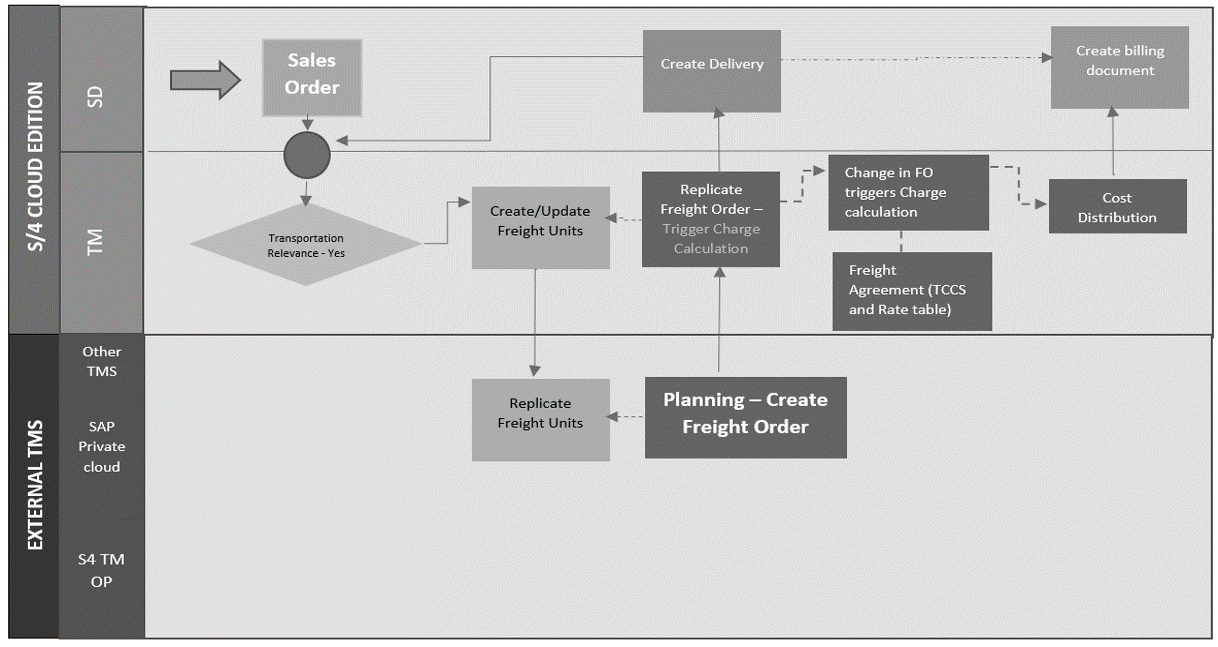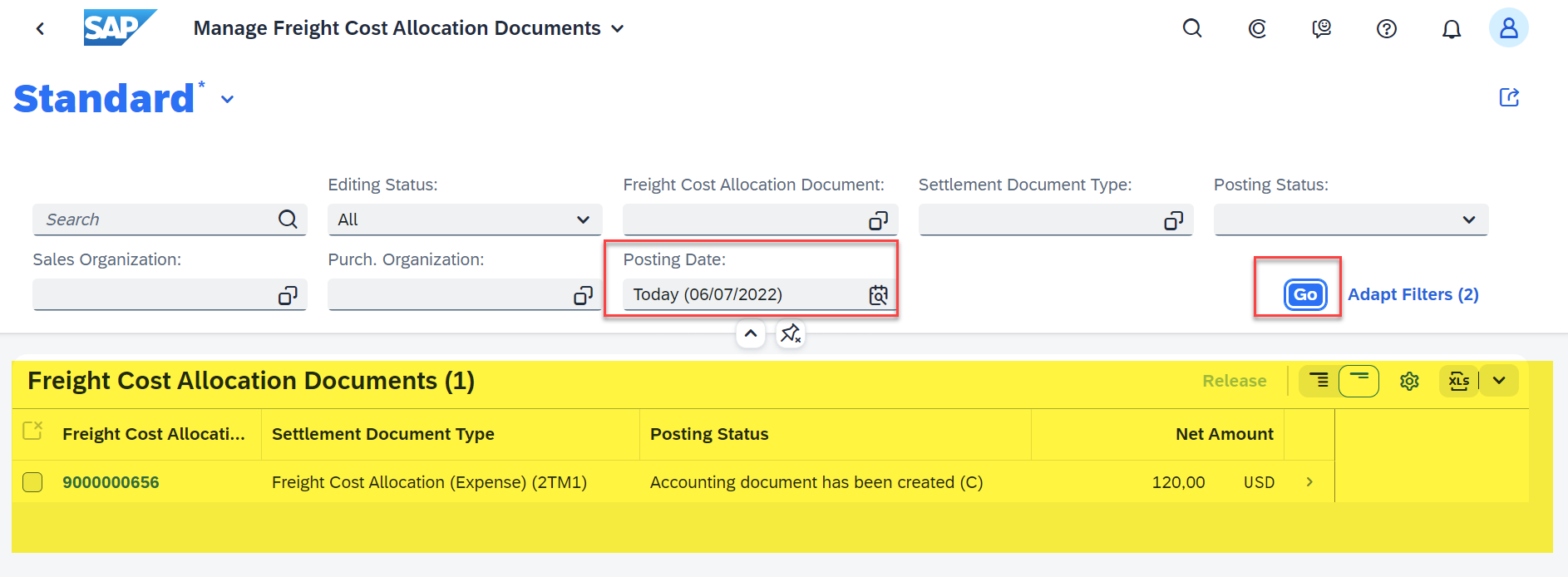
- SAP Community
- Products and Technology
- Supply Chain Management
- SCM Blogs by SAP
- How to Bill Freight Costs to Customer in S4/HANA C...
Supply Chain Management Blogs by SAP
Expand your SAP SCM knowledge and stay informed about supply chain management technology and solutions with blog posts by SAP. Follow and stay connected.
Turn on suggestions
Auto-suggest helps you quickly narrow down your search results by suggesting possible matches as you type.
Showing results for
Product and Topic Expert
Options
- Subscribe to RSS Feed
- Mark as New
- Mark as Read
- Bookmark
- Subscribe
- Printer Friendly Page
- Report Inappropriate Content
06-07-2022
9:39 AM
In TM Shipper scenarios which are initiated from the Sales order (3EP – Order-based Transportation Consolidation, which is based on the scenario BD9 – Sell from Stock ) , such transportation cost of the freight order would be of interest in the context of the Sales order or delivery. Billing freight cost to customer is one of the key requirement. Some of the purposes of the freight cost flow through in the process of a Sale by the seller to the buyer of the product:
The business process takes place in two systems as depicted in Fig. 1.1 The S/4HANA public cloud system covers the main steps of the Sell from Stock process whereas the transportation planning is done externally, either in a 3rd party system or in a S/4HANA On Premise running in a private cloud.
The process starts with the creation of a sales order as described in the Sell from Stock (BD9) scope item. With the creation of the sales order, freights units (FUs) are created as the first step of the 3EP scenario. These freight units will be replicated to the external planning system to do the transportation planning. The planning process is possible with certain limitations, that are not described in detail here.
Once the transportation planning is done, freight orders (FO) have been created which shall be replicated to the public cloud again. Thereby the freight units will be assigned to the freight order in the public cloud system and the aggregated loading and unloading times will be propagated to the freight units.
Based on freight orders, the user can start the creation of deliveries by building delivery proposal using the data of the related freight units. With the delivery creation, the freight units will be reassigned from the sales order to the delivery(s). It’s expected to have a contract between the purchase organization and carrier. This is basically the freight agreement which dictates the respective freight charges and rates agreed based on logistical data like gross weight, gross volume etc. The Charge calculation is performed and calculated without any calculation errors. The follow-on cost distribution is performed in the freight order. The Cost distribution has been performed in the Freight Order without any errors. Finally, API/integration Interface which would provide this cost distribution data to SD Billing.
Preprocessing Steps:
Cost Distribution should be done in the Freight Order, refer to the blog post "How Transportation Management's Cost Distribution works in SAP S/4HANA Cloud".
Steps:
Login as "transportation_mgr" and go to the app "Monitor Accruals Posting".
Click "For Confirmation" tab and open the freight order which was created.
Click "Confirm for Posting" button in freight order.
Go to the app "Freight Cost Allocation Document".
Open the relevant Freight Cost Allocation Document,
In General information Tab:
Settlement document type should be “Freight cost Allocation (Expense)(2TM1).
In Item Tab:
Check Freight cost Allocation document items gross Amount, It should be same as Distribution Amount in Distribution tab of Freight order.
In Profitability Tab:
To Create Billing Document, login as user 'Billing_Clerk'.
Go to "Create Billing Documents" app, enter the Outbound Delivery number in SD Document field and click GO.
Select the Delivery and click "Create Billing Documents", a billing document page opens, save the document.
Go to "Display Billing Documents" app and open the newly created billing document.
Check the Pricing Conditions list in both header and item, the Freight Cost related Pricing condition ZTM1(in our example) should be displayed.
Summary: In S4HCE, we can bill the customer using the freight costs which are pulled from the execution document based on the distributed costs in Freight Order.
Please Note: The above example is relevant only for sub-contracting scenario
- Billing the freight cost to the buyer to charge back freight cost incurred by the seller.
- Ability to provide a freight cost estimate upfront in the sales process to the customer either during the sales quotation process or latest during the sales order creation.
 Fig1.1
Fig1.1
The business process takes place in two systems as depicted in Fig. 1.1 The S/4HANA public cloud system covers the main steps of the Sell from Stock process whereas the transportation planning is done externally, either in a 3rd party system or in a S/4HANA On Premise running in a private cloud.
The process starts with the creation of a sales order as described in the Sell from Stock (BD9) scope item. With the creation of the sales order, freights units (FUs) are created as the first step of the 3EP scenario. These freight units will be replicated to the external planning system to do the transportation planning. The planning process is possible with certain limitations, that are not described in detail here.
Once the transportation planning is done, freight orders (FO) have been created which shall be replicated to the public cloud again. Thereby the freight units will be assigned to the freight order in the public cloud system and the aggregated loading and unloading times will be propagated to the freight units.
Based on freight orders, the user can start the creation of deliveries by building delivery proposal using the data of the related freight units. With the delivery creation, the freight units will be reassigned from the sales order to the delivery(s). It’s expected to have a contract between the purchase organization and carrier. This is basically the freight agreement which dictates the respective freight charges and rates agreed based on logistical data like gross weight, gross volume etc. The Charge calculation is performed and calculated without any calculation errors. The follow-on cost distribution is performed in the freight order. The Cost distribution has been performed in the Freight Order without any errors. Finally, API/integration Interface which would provide this cost distribution data to SD Billing.
Preprocessing Steps:
Cost Distribution should be done in the Freight Order, refer to the blog post "How Transportation Management's Cost Distribution works in SAP S/4HANA Cloud".
Steps:
Login as "transportation_mgr" and go to the app "Monitor Accruals Posting".
Click "For Confirmation" tab and open the freight order which was created.
Click "Confirm for Posting" button in freight order.

- A Message saying freight order posted should be displayed.
- Posting status should change to Posted from ready for confirmation.
- Posting status of All charge Elements in charges tab should be posted.
Go to the app "Freight Cost Allocation Document".

Open the relevant Freight Cost Allocation Document,

In General information Tab:
Settlement document type should be “Freight cost Allocation (Expense)(2TM1).

In Item Tab:
Check Freight cost Allocation document items gross Amount, It should be same as Distribution Amount in Distribution tab of Freight order.
- Now click on any item of Freight cost Allocation document item

In Profitability Tab:
- Check Sales order Number – This should be same sales order used in the Freight order.
- Company code – This should be same as the company code used in the Freight order.
- In Pricing Elements Tab :
- Check that only one condition (TM Cost Distribution (FF08)) is display.
In Reference Document Information Tab:
- Here you should be able to see the reference documents. Ex Sales order, Delivery, Freight order As shown Below.

To Create Billing Document, login as user 'Billing_Clerk'.
Go to "Create Billing Documents" app, enter the Outbound Delivery number in SD Document field and click GO.
Select the Delivery and click "Create Billing Documents", a billing document page opens, save the document.

Go to "Display Billing Documents" app and open the newly created billing document.
Check the Pricing Conditions list in both header and item, the Freight Cost related Pricing condition ZTM1(in our example) should be displayed.



Summary: In S4HCE, we can bill the customer using the freight costs which are pulled from the execution document based on the distributed costs in Freight Order.
Please Note: The above example is relevant only for sub-contracting scenario
- SAP Managed Tags:
- SAP Transportation Management,
- SAP S/4HANA Public Cloud
Labels:
2 Comments
You must be a registered user to add a comment. If you've already registered, sign in. Otherwise, register and sign in.
Labels in this area
-
Business Trends
169 -
Business Trends
24 -
Catalog Enablement
1 -
Event Information
47 -
Event Information
4 -
Expert Insights
12 -
Expert Insights
38 -
intelligent asset management
1 -
Life at SAP
63 -
Product Updates
500 -
Product Updates
66 -
Release Announcement
1 -
SAP Digital Manufacturing for execution
1 -
Super Bowl
1 -
Supply Chain
1 -
Sustainability
1 -
Swifties
1 -
Technology Updates
187 -
Technology Updates
17
Related Content
- SAP Business Network for Logistics 2404 Release – What’s New? in Supply Chain Management Blogs by SAP
- RISE with SAP Advanced Logistics Package in Supply Chain Management Blogs by SAP
- SAP Transportation Management Analytics in Supply Chain Management Blogs by SAP
- Advanced Shipping and Receiving – Go-live support insights in bgRFC based EWM-TM integration in Supply Chain Management Blogs by SAP
- Sending ASN from Freight Order (embedded TM) in Supply Chain Management Q&A
Top kudoed authors
| User | Count |
|---|---|
| 10 | |
| 8 | |
| 6 | |
| 4 | |
| 4 | |
| 3 | |
| 3 | |
| 3 | |
| 3 | |
| 2 |